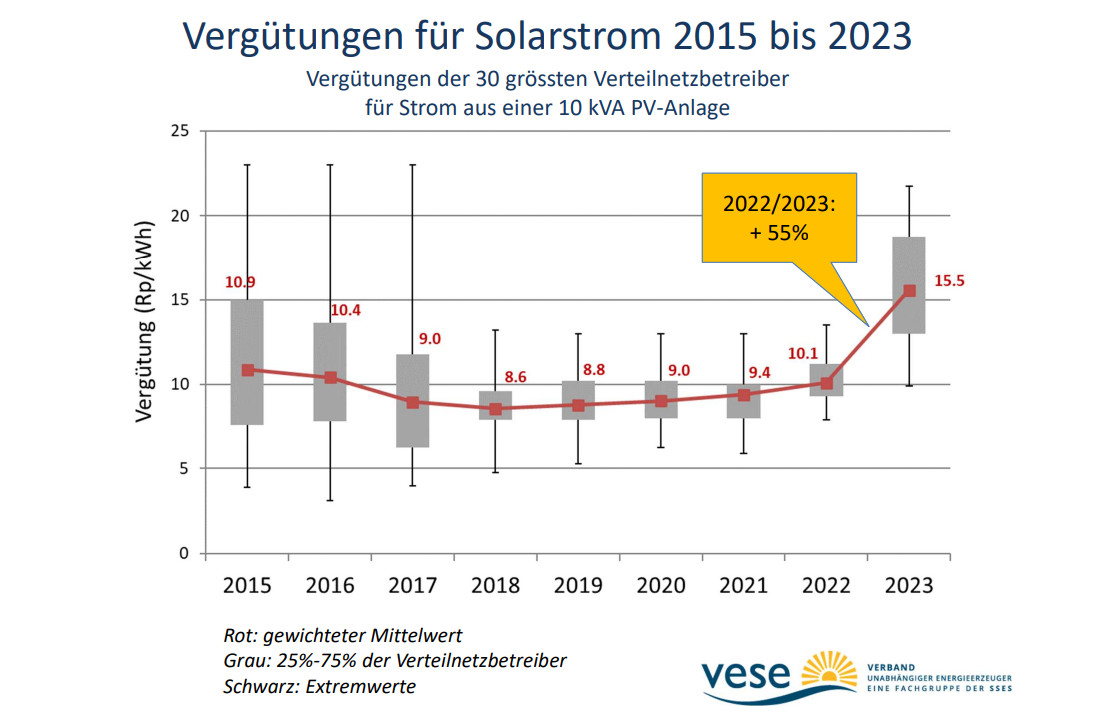From pv magazine Germany
In Switzerland, operators of PV systems that inject surplus solar power into the grid will receive significantly more money in the coming year. Network operators will increase remuneration by an average of 55%, which means average rates may rise from CHF 0.101 ($0.10)/kWh to CHF 0.155/kWh on average.
The Swiss Association of Independent Energy Producers (VESE) said there is still no guarantee that operators of PV systems in Switzerland will receive remuneration that covers rising electricity costs. VESE is therefore calling for a new remuneration model.
The new figures from VESE are based on information from the 30 largest network operators. They determine the remuneration for surplus solar power fed into the grid every year.
VESE said it welcomes the fact that solar power is finally being upgraded as a reliable and ecological mainstay of domestic renewable energy generation. The association noted that “even notorious brakemen among network operators” have finally reached and exceeded the threshold of CHF 0.10/kWh, which VESE has been demanding for a long time.
But this does not happen entirely on a voluntary basis. VESE said this is mainly due to the fact that under the current legal situation, producers with load profile measurement could switch very easily. They could therefore also sell their solar power on the futures markets, where the effective price is currently between CHF 0.20/kWh and CHF 0.30/kWh.
“The network operators were therefore forced to counteract this migration by massively increasing their remuneration. In view of the high market prices, they might otherwise have missed out on the relatively cheap electricity from independent producers,” said VESE.
While the operators of PV systems are now benefiting from higher electricity prices, the association also noted an “unwanted effect” caused by the sharp increase in remuneration. Prices for electricity consumers would also rise, as network operators would pass on the higher payments to consumers.
VESE is in favor of a system that secures the financing of PV systems over the long term, but does not come at the expense of electricity customers. This production cost-oriented “fix model” is supplemented with an associated, purely market-oriented “flex model,” which is popular with associations, politics and administration in Switzerland. The “flex model” allows operators to also participate in the free market if they wish, but with all the advantages and disadvantages.
This content is protected by copyright and may not be reused. If you want to cooperate with us and would like to reuse some of our content, please contact: editors@pv-magazine.com.




1 comment
By submitting this form you agree to pv magazine using your data for the purposes of publishing your comment.
Your personal data will only be disclosed or otherwise transmitted to third parties for the purposes of spam filtering or if this is necessary for technical maintenance of the website. Any other transfer to third parties will not take place unless this is justified on the basis of applicable data protection regulations or if pv magazine is legally obliged to do so.
You may revoke this consent at any time with effect for the future, in which case your personal data will be deleted immediately. Otherwise, your data will be deleted if pv magazine has processed your request or the purpose of data storage is fulfilled.
Further information on data privacy can be found in our Data Protection Policy.